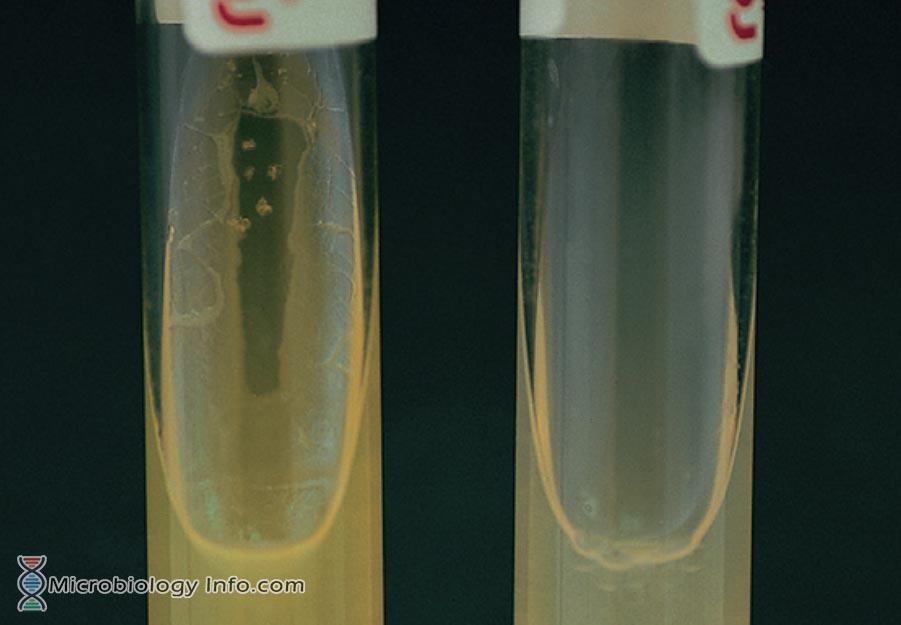Microbes can be roughly classified according to the range of temperature at which they can grow. The growth rates are the highest at the optimum growth temperature for the organism.
The lowest temperature at which the organism can survive and replicate is its minimum growth temperature. The highest temperature at which growth can occur is its maximum growth temperature. However, growth at both extreme cold and hot temperatures require evolutionary adjustments to macromolecules and biological processes.
Only few organisms grow well in such temperature ranges. Thus the effect of temperature on organisms can be observed to differentiate organisms.
Objective
- To differentiate species of the fluorescent pseudomonas group
- To differentiate other non-fermentative bacteria.
Principle
Pseudomonas aeruginosa is member of the Gamma Proteobacteria class of bacteria. It is a Gram-negative, aerobic rod belonging to the bacterial family Pseudomonadaceae. The bacterium is ubiquitous in soil and water, and on surfaces in contact with soil or water. Its optimum temperature for growth is 37 degrees, but it is uniquely able to grow at temperatures as high as 42 degrees. Growth at 42’C has been considered to be a key differential test for separating non-pigmented P. aeruginosa and the other species of fluorescent pseudomonads.
Thus the test is used to determine the ability of an organism to grow at 42°C. For this the organism is cultured on an agar medium and then incubated at a high temperature of 42°C. Only organisms that are capable of enduring the temperature grow while others do not. Several Pseudomonas species have been isolated in the clinical laboratories that are capable of growth at elevated temperatures. The differentiation of apyocyanogenic Pseudomonas aeruginosa from the other fluorescent pseudomonads is clinically important due to the seriousness of infections caused by P. aeruginosa.
Method
- Inoculate two tubes of trypticase soy agar (TSA) with a light inoculum by lightly touching a needle to the top of a single 13- to 24-hour-old colony and streaking the slant.
- Immediately incubate one tube at 35°C and one at 42°C.
- Record the presence of growth on each slant after 18 to 24 hours.
Expected Results
- Positive: Good growth at both 35°and 42°C
- Negative: No growth at 42°C, but good growth at 35°C.

Growth at 42°C. A, Positive; good growth. B, Negative; no growth.
Uses
- Growth at 42oC is advocated to differentiate species of the fluorescent pseudomonas group as well as to differentiate other non-fermentative bacteria.
- This test is mostly used to differentiate a pyocyanogenic pseudomonads from other Pseudomonas
Limitations
- The constancy in test results using nonfermentative bacteria is not only method dependent but also strain dependent.
- Although the test for growth at 42 degrees C is important as a taxonomic tool when used under controlled conditions, other tests such as acetamide are preferred as a substitute for use in the clinical laboratory.
References
- Tille, P. M., & Forbes, B. A. (2014). Bailey & Scott’s diagnostic microbiology (Thirteenth edition.). St. Louis, Missouri: Elsevier.
- textbookofbacteriology.net/pseudomonas.html
- https://courses.lumenlearning.com/microbiology/chapter/temperature-and-microbial-growth/
- (1979). Growth of non-fermentative bacteria at 42 degrees C. Journal of clinical microbiology, 10(6), 800-4.
- https://link.springer.com/referenceworkentry/10.1007%2F978-3-642-40872-4_1610-2

Growth at 42°C. A, Positive; good growth. B, Negative; no growth.
Please confirm at 35 C there is no growth for pseudomonas bacteria?